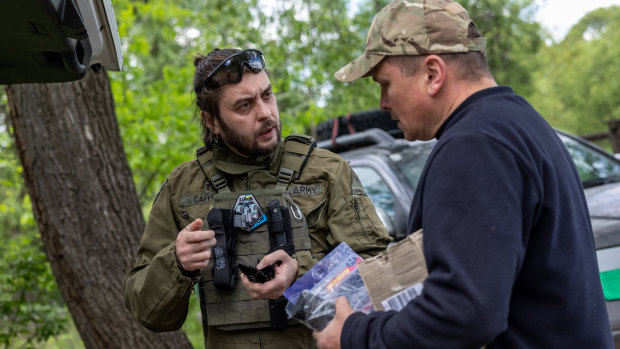This was published 1 year ago
Opinion
The village that repelled Putin in the first digitised people’s war
Mick Ryan
Military leader and strategistThis week, I had the opportunity to visit the small village of Moschun, a short distance north of Kyiv. In the early stages of the February 2022 Russian invasion, this hamlet became the focal point for a large part of Russia’s northern army. The Russians needed the well-located village as an intermediate step on their way to the Ukrainian capital.
Almost 30,000 Russian soldiers conducted two weeks of vicious ground, air, rocket and artillery attacks against the single Ukrainian brigade defending Moschun.

A Ukrainian civilian volunteer brings supplies to troops near a frontline position. Credit: Getty
Throughout, the people of the village didn’t run away. They stayed and cooked and fed the Ukrainian soldiers. They used their cars and trucks to haul ammunition, including the critical Javelin missiles, to forward defensive positions. Some even employed Molotov cocktails against unsuspecting Russian soldiers, giving them a “warm welcome” to Ukraine. Two weeks later, the Russians withdrew after suffering massive casualties.
The local people, having played a key part in helping the army defend their village, immediately began rebuilding. This included a memorial to the 90-plus Ukrainian soldiers killed in the battle.
The Battle of Moschun is representative of a larger trend in Ukraine’s defensive strategy: a 21st century people’s war.
The idea of a people’s war was conceived by Chinese revolutionary leader Mao Zedong. He employed it to fight a war by maintaining popular support while drawing an enemy deep into the countryside and attacking it through a mix of conventional and unconventional tactics. This had a military objective, which was to bleed the enemy of manpower and supplies. Importantly, it also had the political objective of wearing down the will of the enemy politicians and citizens.
In many respects, Ukraine has adopted a 21st century, digitised people’s war. There are three key elements to how Ukraine has embraced a whole-of-society approach to defending itself against the predations of its brutal Russian neighbour.
First, Ukraine nurtured popular support for its war effort through a focus on societal unity. President Volodymyr Zelenskyy has consistently employed themes of unity, sovereignty and reinforcement of Ukrainian culture. This has provided a crucial sense pf purpose for both soldiers and citizens. The Ukrainian government has employed its Territorial Defence Force as an effective way for local people to contribute to the defence of Ukraine. And, perhaps more importantly, the Ukrainian military has taken pains to use battlefield tactics that limit casualties to preserve both the force and its social licence with the Ukrainian people.
This popular-support element of the Ukrainian people’s war has manifested in a range of other ways where citizens are directly contributing to the defence of Ukraine. Crowdfunding has been a significant effort. It has raised enormous sums to purchase everything from socks to armoured vehicles, from medical kits to satellites. Smart-device applications, developed by private industry and used by various parts of government, allow Ukrainians to report on enemy movements or report enemy drones and missiles flying overhead. These kinds of initiatives have seen a much larger proportion of society involved in directly supporting the war effort than in many previous conflicts.
A second element of the Ukrainian people’s war has been the constant wearing down of the Russian military. In earlier articles, I have described this as a strategy of corrosion. This is a focus on slowly but surely attacking the Russians physically and psychologically to destroy their combat potential. The most obvious parts of this are the large-scale ground campaigns in 2022 and 2023 which have attacked the Russians in the north, the east and south of the country. It also incorporates maritime strikes against the Russian Black Sea fleet using drones, missiles and uncrewed attack boats.
Added to these conventional attacks have been widespread partisan activities in areas occupied by Russia. Established as part of a national resistance law by Ukraine in 2021, Ukrainian citizens provide intelligence of Russian troop concentrations, headquarters and supply dumps. These are then attacked with missiles, special forces or the resistance members themselves.
The final element of Ukraine’s digital-age people’s war has been its accelerating effort to corrode Russian political support for the war. Early in the war, Ukraine had limited ability to conduct long-range strikes against Russia, but it did have an active IT sector. It leveraged this, social media and Zelenskyy’s speeches to implement a global strategic-influence program to degrade support for Russia. This has included “hacktivists” and the global NAFO (North Atlantic Fella Organisation) movement to address Russian misinformation campaigns.
More recently, these political attacks on Russia have embraced long-range attacks on Moscow as well as Russian military airbases. They have also included incursions by separatist groups into Russia’s Belgorod region. These spectacular attacks are designed to highlight to the Russian people the ongoing (and growing) cost of Putin’s war against Ukraine. They aim to decrease the stature of Putin and the Russian military in the eyes of Russians – and their foreign supporters.
Ukraine’s new-era people’s war is an effective strategy for a smaller country attacked by a larger nation. While military forces might fight battles, it is actually nations that fight wars. The people of the tiny village of Moschun courageously demonstrated in early 2022 how an old idea about a people’s war can be dusted off and modernised by a democracy to defend one’s country in the 21st century.
Mick Ryan is a retired major general who served in the ADF for more than 35 years and was commander of the Australia Defence College. He is the author of War Transformed and an adjunct fellow at the Centre for Strategic and International Studies in Washington DC.